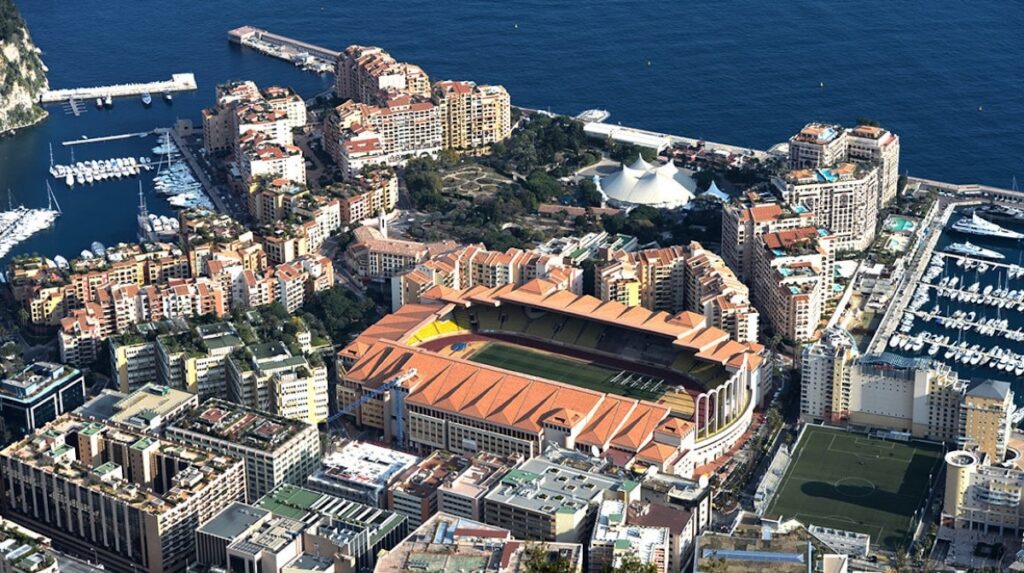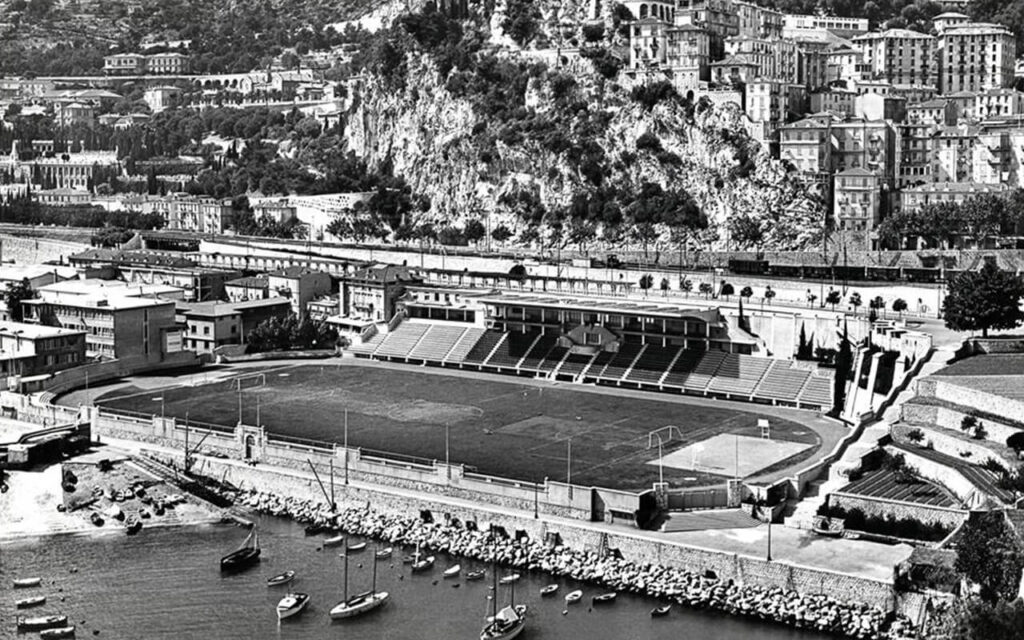Facelift for Louis-II stadium soon? Here’s what we know

Its sleek architecture, its ability to blend in with the Monegasque landscape and its capacity to house several facilities within the same complex make the Louis-II stadium unique in Europe, or indeed in the world. Built in the 1980s, the sports stadium may soon be refurbished, as requested by the National Council in early December.
Let’s go back in time. 25 January 1985. After four years of construction work, nearly 120,000 m3 of concrete, 9,000 tons of iron and over 2,000 tons of steel structure on a piece of land reclaimed from the sea, the new Louis-II stadium emerged, replacing the old one (1939-1985), which was razed to the ground, making way for the Fontvieille shopping centre.
The date is a historic one. The following day, AS Monaco inaugurated their new stadium in the best possible way, with a clear victory (3-0) over RC Lens. The ensuing years were a honeymoon period for the club in its new home.
A multi-faceted stadium, Monaco’s sporting home
The greatest moments of AS Monaco’s history took place here, notably on the European stage, with memorable victories over Real Madrid (3-1) and Chelsea (3-1) during the Red and Whites’ stunning 2003-2004 Champions League campaign.
The stadium also hosted the French national team in 1988 for a friendly match against Morocco, which Les Bleus won 2-1.
But the second-generation Louis-II stadium is not just about AS Monaco and football. There are many facilities within the complex. In total, more than thirty organisations have their headquarters in the stadium.


In addition to the pitch and the athletics track, the Louis-II is home to the Prince Albert II water sports centre with its Olympic swimming pool, the Gaston-Médecin sports hall, home of the Roca Team, a number of Monegasque administrative departments, and a private English-language university, the International University of Monaco (IUM).
Before moving to the Performance Centre in La Turbie and La Diagonale in Cap d’Ail, all of AS Monaco’s administrative offices and its training centre were also located in the stadium.
With so many disciplines, the sports complex has certainly had its share of memorable occasions. Since 1987, the stadium has hosted the prestigious Herculis Meeting and was also the venue for the IAAF World Athletics Finals in 2003, 2004 and 2005.
Apart from its sporting credentials, the Louis-II has also seen some big names in music, such as Muse for a concert in 2007, or the Eagles in 2011, on the occasion of Prince Albert II and Princess Charlene’s wedding.
The fans immediately embraced Louis-II in the 1990s because of its authenticity and modernity, but today the regulars would like to see their stadium renovated, as would the National Council, where the subject was broached during a public budgetary session on 12 December. “I would ask you, Minister, to carry out the necessary repair work on the arches as soon as possible, as they are regularly shown on television during sporting events, and their poor condition does not convey a fitting image of our Principality. May I remind the Government of the importance of renovating the user facilities as soon as possible, such as the refreshment areas or the stands, which must be a priority”, commented Marine Grisoul, President of the Education, Youth and Sport Committee.
After almost 40 years, the stadium has certainly begun to show signs of wear and tear, but the Monaco Government stressed, in the Gazette, that “the Louis-II stadium is a sports facility that was put into service in January 1985 and since its opening, it has been used every day of the year from 7 am to 11 pm. At almost 40 years old, it is not unusual for the building and its fittings to be showing signs of age. However, in view of the frequency of use mentioned, it could be said that the facility has aged rather well.”
And in response to the concerns expressed by the National Council, Patrice Cellario said that the structural condition of the arches mentioned above “poses no risk. The design aspects for the arches’ cosmetic renovation will be drawn up during the first quarter of 2023. The report is expected in early January. As for restructuring the stadium’s public reception areas, this would have to form part of the overall restructuring project already envisaged for the Louis-II stadium. It would be unfortune to undertake work that would then be demolished in the short to medium term. On the other hand, a study has already been launched into improvements that could be made, particularly to the refreshment stands, so that the spectators’ experience is improved on this point,” proof once again of the Executive’s active interest in the issue.
Renovations are expected to accelerate in the coming years
As well they should since the Louis-II stadium renovation has been a stated priority for the Government since 2017. Nearly 20% of the 355 million euros that were approved for restructuring Louis-II has been spent over the last five years, renovating the Albert II water sports centre, the VIP boxes, the pitch (which now provides better grip), the athletics track, the lighting (replaced by LEDs), the forecourt and the Gaston-Médecin sports hall, as Sylvie Bertrand, the stadium’s director, reminded Monaco Info in 2020.

🔴⚪️ La nouvelle salle Gaston-Médecin se dévoile ! @ASMonaco_Basket pic.twitter.com/Xg051KfjdM
— Romain Boisaubert (@R_Boisaubert) September 27, 2022
The new Gaston Médecin sports hall was inaugurated on 28 September 2022 after 13 intense weeks of work
The hall, a real aesthetic gem, immediately won the fans over. Football fans will be hoping that the Government will continue this momentum, so that the supporters can cheer AS Monaco on in a completely refurbished stadium.
This is not an impossible dream, since, as Patrice Cellario’s staff told Monaco-Matin: “work is going ahead in phases. The phases that could be carried without too many difficulties have already been completed (water sports centre, VIP boxes, pitch, athletics track, forecourt, Gaston-Médecin sports hall). At the same time, studies are ongoing and will last for at least two more years. It is a particularly complex subject, especially in terms of the timing of the different phases and work, taking into account the building’s operations. Given the constraints implied by keeping the stadium operational, which is a requirement, it is reasonable to assume the restructuring operation will take about ten years to complete.”
AS Monaco, which does not own the stadium, was keen to reassure everyone at the season ticket holders’ event at the start of the season.
According to the club’s management: “this is one of the most important issues in terms of our future growth. We are by far the biggest users of the stadium. We are in discussion with the Monegasque authorities regarding future work on the stadium. It’s a complicated project, but it is underway and is very ambitious.”
New refreshment stands and red and white seats
The fans are not short of ideas on how to breathe new life into the iconic venue.
These include providing new refreshment areas and replacing the current yellow seats with seats in the AS Monaco colours. For the record, it was Prince Rainier III who chose yellow in 1985, as he wanted the same colour for all the sports halls, as Sylvie Bertrand explains. “I think they will be changed one day, and it will up to the Sovereign Prince,” she says.
Salut la communauté monégasque 👋
— Romain (@MilieuRelayeur) August 12, 2021
Voici une proposition pour relooker un peu notre stade Louis II bien vieillissant, aux couleurs du club. J’ai beaucoup hésité sur la couleur des sièges, et j’hésite encore, alors vos remarques sont les bienvenues !
RT apprécié👍#Daghe🔴⚪️ pic.twitter.com/XNQompnP3n
This is not a new topic. Using banners, the Monaco 1994 Ultras have repeatedly expressed their wish to have red and white seats for the club’s 100th anniversary, which will be celebrated in 2024.
“The stadium’s opening was a fantastic time,” recalls Raymond Viano, a season ticket holder since the 1965-1966 season. “We had one of the most beautiful stadiums in Europe, even the English were impressed when they came here. But the stadium hasn’t aged well.”
Michel Debrieuvre, a member of the AS Monaco supporters’ club, suggests opening a restaurant in the Louis-II, as other stadiums have done, or at least increasing the number of refreshments stands to avoid them being overrun.
Avoiding complete closure
Monaco fans hope that the Louis-II will soon get a new look, given the recent renovations of the other Ligue 1 stadiums they have seen during away matches.
Sièges «Jaunes» en Loge…😡
— 🏎🇲🇨GlennTheBest🇲🇨⚽️ (@glenthe_best) October 28, 2021
Quelle honte d’accueillir des VIP dans des sièges aussi crades. Je ne parle même pas de l’état des couloirs pour accéder aux loges et aux tribunes.Digne d’un club de National et encore!@GvtMonaco @AS_Monaco pic.twitter.com/bBgLJQZdxV
Toulouse has renovated its Stadium, Angers has refurbished almost the entire Raymond Kopa stadium featuring brand new black seats, or even Nice, which plays in an Allianz Riviera that was inaugurated less than ten years ago… these examples are cited by Monaco fans as they suggest ways of improving the Principality’s stadium.
But the Louis-II stadium is not the only one undergoing a transformation: the Costières stadium in Nîmes (opened in 1989) is due to be demolished in 2023 and completely rebuilt in 2026. The François-Coty stadium in Ajaccio (opened in 1962) recently published an online questionnaire aimed at fans to find out what they would like to see improved after the latest major works carried out this summer.
More recently, Prince Albert II himself mentioned Louis-II, ahead of Monaco’s National Day. “I hear the frustration of our supporters, to whom I would like to pay tribute on the 70 years of their (supporters’ – Ed.) club and for their loyal support,” he told Monaco-Matin.
“The Louis-II stadium is not just a football stadium but a sports complex, which was delivered in 1985 in line with specifications that no longer necessarily meet today’s needs. This does not mean that we are not providing sportsmen and women with decent facilities. But I do recognise that some parts of the stadium have not aged well.”
A statement that could prompt the government to act quickly. “The building is undergoing a phased renovation,” explained the Sovereign. “This renovation programme will probably have to be stepped up. We are in the process of reviewing and updating this programme. Avoiding complete closure of the stadium, while finding phased timescales to suit everyone.”
This is the real challenge of modernising the Louis-II stadium. To continue to host all the sports and supporters, while carrying out major work.
With contributions by Camille Esteve









